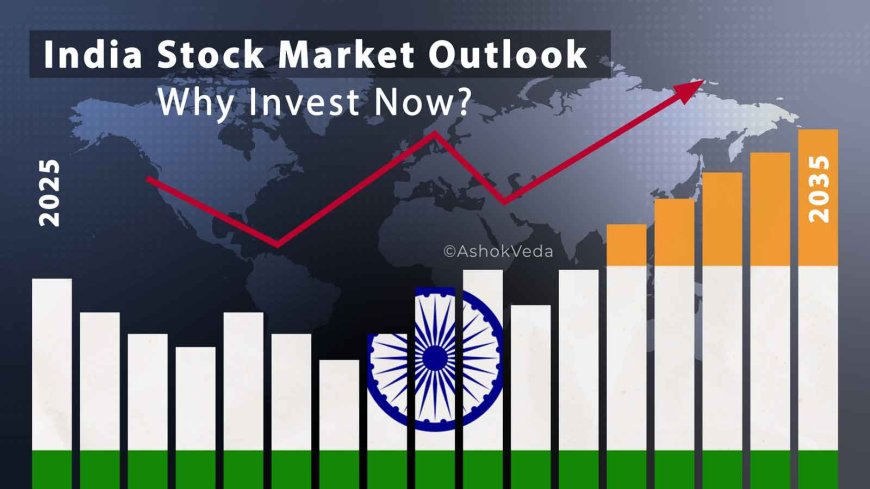India Stock Market Outlook 2025–2035: Why Invest Now
Discover why India is a top investment destination for the next decade. Explore returns, risks, sectors, and strategy for NSE & BSE from 2025–2035.

As global markets wrestle with high debt, aging populations, and geopolitical uncertainty, India presents a compelling growth story for long-term investors. Fueled by strong demographics, rising exports, policy reforms, and strategic sectoral expansion, the Indian equity markets (NSE and BSE) are poised to deliver substantial returns over the next 10 years.
This article dives into data-backed projections, sectoral outlooks, macroeconomic indicators, and key risks to help global and domestic investors make informed decisions about investing in India until 2035.
Projected Returns: Indian Equity Markets (NSE, BSE)
-
Based on insights from Jefferies and Goldman Sachs, Indian equities could generate 12–15% CAGR over the next decade (Business Standard).
-
In bullish cases driven by infrastructure and export booms, returns may reach 20%+ CAGR
Macroeconomic Drivers
1. India’s Economic Strategy
-
As per the Economic Times, India's growth themes include infrastructure, green energy, digital stack, and manufacturing incentives (ET).
-
The government aims to expand merchandise and service exports to $1 trillion each by 2030 (World Economic Forum).
2. Currency Outlook (INR vs USD/Euro/Yuan)
-
INR is likely to remain between 84–90 per USD by 2030, with RBI using its $600B+ reserves for stability (RBI Data).
-
Despite structural depreciation, India’s stable macroeconomic fundamentals and trade diversification reduce vulnerability.
3. Geopolitical and US Debt Risks
-
Rising US debt (projected >130% of GDP by 2035) could cause capital outflows from risk assets (CRFB.org).
-
India’s domestic demand, forex reserves, and policy prudence offer resilience, but external shocks (e.g., oil spikes, dollar crisis) remain key risks.
Sectoral Analysis: Key Opportunities
| Sector | Outlook | Key Growth Drivers |
| Defense | Bullish | Exports (e.g., BrahMos), Make in India, $100B+ modernization push |
| FMCG | Moderate | Rural consumption growth, premiumization |
| Electronics | Bullish | PLI schemes, Apple/Samsung shift, semiconductor policy |
| Auto (EV) | Bullish | Strong EV penetration, battery manufacturing, 2W dominance |
| Energy | Mixed | Renewable investments, hydrogen; but crude import risk persists |
| Data/IT | Bullish | AI/data centers, global services leadership |
| Manufacturing | Very Bullish | PLI, China+1 strategy, infra build-out |
India vs Global Markets (2025-2035)
| Region | Projected 10-yr CAGR | Observations |
| India | 12–15% | Strong demographics, policy tailwinds |
| US (S&P 500) | 6–8% | Slower growth, debt risks |
| Europe | 4–6% | Structural stagnation |
| China | 5–7% | Regulatory headwinds, debt overhang |
| EM (ex-India) | 5–8% | High volatility, inconsistent governance |
Risk Factors and Probabilities
| Risk | Probability | Impact |
| US Debt or Dollar Crisis | Medium | -15% to -30% drawdown in Indian equities |
| Crude Oil Shock (> $120/barrel) | Medium | Trade deficit, inflation surge |
| Major Geopolitical Conflict | Low-Medium | Market panic, global slowdown |
| INR sharp depreciation (>95/USD) | Low-Medium | Import costs spike, capital outflows |
| Domestic Political/Economic Instability | Low | Short-term volatility |
Investment Strategy Recommendations
-
Equity Allocation: Domestic and foreign investors may allocate 50–60% to Indian equities, especially large-cap, manufacturing, and energy transition plays. -
Diversification: Maintain 10–15% exposure to global equities to hedge geopolitical risk. -
Defensive Holdings: Include gold (5–10%) and bonds (15–20%) for stability. -
SIP Strategy: Recommended to reduce volatility risk and benefit from India’s long-term structural growth.
Conclusion: Why Stay Invested in India
India is uniquely positioned among global economies with its young population, tech infrastructure, expanding manufacturing base, and global investor interest. Despite global headwinds, its structural resilience makes it a compelling long-term bet.
Projected Average Return (2025–2035): 12–15% CAGR, with scope for higher upside.
For long-term investors, India offers a powerful combination of growth, diversification, and stability. Staying invested with a disciplined strategy could yield substantial rewards over the next decade.
-
Business Standard (2024) – Indian Stock Market Long-Term Outlook
-
Economic Times (2023) – India's Growth Themes
-
World Economic Forum (2024) – India's Export Strategy
-
Reserve Bank of India (2024) – RBI Forex Reserves
-
Committee for a Responsible Federal Budget (CRFB.org) – US Debt Projections
-
LiveMint (2024) – Stock Market Long-Term View





































